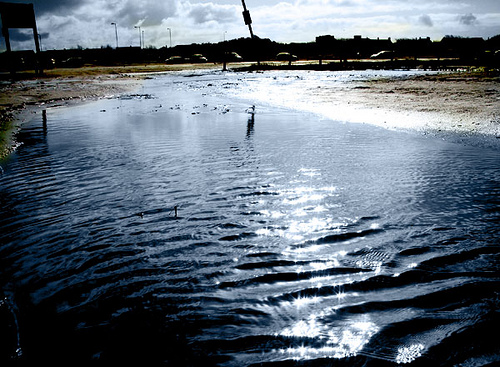Author Stephen Solomon recently suggested we need an “Al Gore of water” — a public champion to raise the profile of water scarcity threats and opportunities, as Gore has done for climate change. Solomon, an economics journalist, makes a bid for that role himself with his new book Water: The Epic Struggle for Wealth, Power, and Civilization. It’s one of the first Big Important Books of 2010, a 496-page survey of water’s role in shaping civilizations throughout history, from Roman aqueducts to the oceanic “moat” that protected a young United States.
Solomon argues that water is poised to resume its place as the world’s most important natural resource, a position only briefly (in the long view) held by oil. He says the world’s booming population will bring water back to the forefront, while an increasingly unpredictable climate will make freshwater all the more difficult to manage. Here’s an edited version of our recent conversation.
 Q. We’ve just finished the exhausting Copenhagen process, the economy’s still tanked, and it’s the middle of winter. How dare you raise another sucky global problem?
Q. We’ve just finished the exhausting Copenhagen process, the economy’s still tanked, and it’s the middle of winter. How dare you raise another sucky global problem?
A. Yes, of course.
Q. Let’s talk about how freshwater scarcity and climate change relate and build off each other.
A. They’re totally inseparable. Climate change turns what are water crises into catastrophes. Climate expresses itself through extreme precipitation events — extreme droughts and flooding. Storms that are more intense but also more unpredictable and out of season.
One thing that leads to is national security and failed state issues. I’ll give you one example: Pakistan, where the U.S. has invested enormous resources, is a nuclear-armed state with a rift with the Taliban, and it’s already a bit of a failing state. Soon it’s going to have one third of its water from in the Indus River — its main water lifeline — dry up from the lost glacier melt. At the same time, its population is increasing by 30 percent. So in the next 15 years, we can imagine a country that’s already on the brink, dealing with a loss of 30 percent of its water while the population increases by 30 percent.
The United States understands the problem because it agreed in December to pump in $7.5 billion to Pakistan. Half of that is going to water-related projects — storage, irrigation, and hydropower.
Q. You describe water scarcity as a justice issue, between haves and have-nots. With climate change, too, the most harmful effects happen in the countries that did the least to cause them. Is this a helpful way to look at these issues?
A. Economic justice isn’t the only way to look at these issues, but I think it’s a valid way. It’s often the poor within a country who are most remote from water resources. In a city like Delhi, for example, there are subsidies for piped drinking water, but the poor don’t get the advantage of it because they don’t have pipes. So the rich get subsidized by the poor. Plus the poor have to figure out how to forage each day for water, which is a timely and costly enterprise.
In our country, we subsidize irrigated agriculture, especially from the big dams in the West. Those agribusinesses pay virtually nothing for their water, in many cases, while the people in cities and other industries are paying 10 or 15 times the amount.
Water has to reflect its true value, because if it doesn’t have an economic value that reflects its scarcity, it’s going to be misallocated. Free market economies are very efficient in certain things, such as wealth creation. They are also notably not so good at distribution. And water is a form of wealth.
Q. So the solution you’re led towards is pricing water for its full cost, its true cost, and then letting the market figure out who wants to pay for it?
A. You have to do two things at the same time. I put this in free market terms: Task one is to deregulate the subsidies that are out there. The privileged sectors, the invested interests — mainly agribusinesses. Then water can reflect its true value and there can be fair competition between users so it gets allocated for sensible things. And even when the farmers use it, they use it not to grow water-thirsty crops in the desert because they’ve got too much water, but to grow value-added crops. That’s fine.
Second, we need a golden rule: You return the water to the ecosystem in the same condition that you got it. So if the next guy down the stream gets it on the same terms you did more or less. And that of course means pollution laws have to be enforced comprehensively.
 Solomon.Courtesy HarperCollins/Claudine MacéQ. You also write about the economic opportunities that come with smarter water usage.
Solomon.Courtesy HarperCollins/Claudine MacéQ. You also write about the economic opportunities that come with smarter water usage.
A. If we would be a little more intelligent in agricultural water use, the United States could unleash an incredible amount of water for many uses that are now constrained. The same thing has begun happening around the world for all sorts of reasons. The benefits and the incentives are different for a water-scarce country like Australia, which is really up against a wall. They’ve used tradable water rights and they’ve managed to get through a terrible drought as a result. It’s a matter of survival. The same thing is true in Israel.
For the U.S., it’s a matter of deciding to slim down. We have a lot of water in this country, even in the West where there are limitations, but we also have the opportunity to become a mini Saudi Arabia of water. We have five times more water per capita than China, for example. Six times more than India. The Middle East is bone dry. These countries have to import food. So if we really took our water productivity seriously, we could use that for growth. You talked about the problem of no growth in the economy; we’re sitting on an engine that we’re not using. A productive engine.
Q. You’re not talking about exporting water?
A. No. Let’s take California for example. It’s a state that agriculture produces a very small fraction of the wealth, but it uses about 80 percent of the water. For other industries, whether they are services where people live or they are in Silicon Valley, we really would like to tell those guys, “We’ve got plenty of water for you so you can continue to grow and produce your high value returns to the state. Create jobs and wealth.”
But now you have to say, “I’m sorry guys, we don’t have enough water so you guys can’t really locate here.” If you increase the effectiveness of where water is going to the most efficient uses, you increase overall wealth, jobs, and prosperity. And because we are a water-rich country, we would produce a tool that the United States can use not just to grow our own economy but to help strategically to feed the world and make our industries more competitive
Q. And what about individual water users? What can Johnny Q. Flusher do? (Sorry.)
A. Well, first, people should be angry about what’s happened with drinking water. Something like 40 percent of our groundwater is now contaminated because of a lack of EPA enforcement of the Clean Water Act and the Safe Drinking Water Act over the past ten years. It was one of the great policy successes in the last 40 years, and we’ve been backsliding. Twenty million people get sick as a result. Cancers of breast and prostate have risen, which have been tied to water problems. It was a decision made somewhere in the Bush administration not to enforce regulations that were on the books. We should be mad about that, and we should also be mad that in the meantime we haven’t updated the Clean Water Act for new chemicals that are being dumped into our water system.
You can deal with your town and city councils, but in the meantime, you should also test your own water supply. And not just by the tests that meet EPA standards because we know the EPA standards have not been updated. It’s crazy to get bottled water in this world for many reasons as we know, but if we could trust the drinking water, you wouldn’t need it. So that’s one thing.
The other big thing is toilets. They use something like half the water in your house usually, even with more efficient models. Some of the systems in Europe have a two-tiered system. They have low-flow flush for wet waste and … lawn watering is another big issue.
Q. What part of reporting the book left the biggest mark on you?
A. I spent time in Kenya with my wife and daughters, who were in high school at the time, going on to college. You need about $200 dollars to go to high school in Kenya, although the university was free. I met a young man whose family could not afford that $200. So he was studying at night, with no electricity, on the remote chance that he was going to get a scholarship to go to the university in Nairobi. I realized this guy was smart, he was energetic, he was a lovely guy, he had every right to have as much chance as my own kids did, to have that opportunity. It was certainly in the interest of his country to have people like him becoming educated so they could increase their human capital.
He was stuck in this village and I realized that that if there was reliable water when he was younger, they could have used it for small irrigation projects. They could have raised crops and sold enough and this guy probably could have gotten his $200 and probably could have gone on to get his opportunity. A little thing like water means so much. It means women and children don’t have to walk four or five hours a day. It means you might get an extra $200 dollars of income so you can go to university. Talk about inequity. That was a striking feeling — to wonder why this guy, because he’s born in Kenya in a southeast rural village, should be denied what my kids are not and what I’m not. And I realized that we are water. We are 70 percent water. We need it.
Here’s Solomon’s Jan. 5 appearance on “Morning Joe”:



